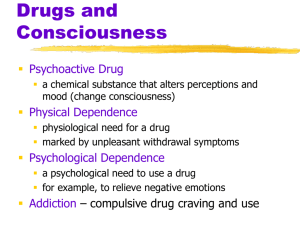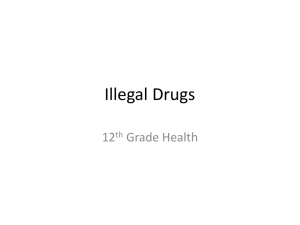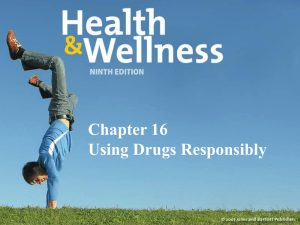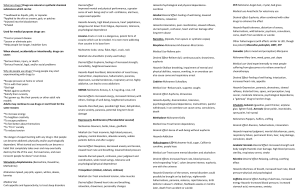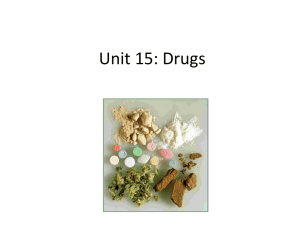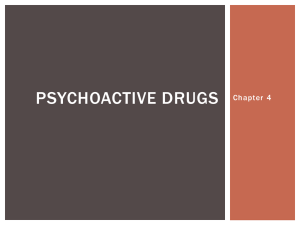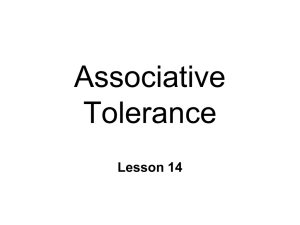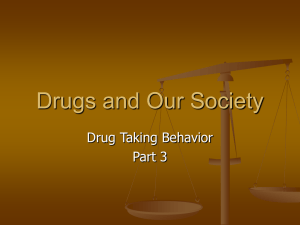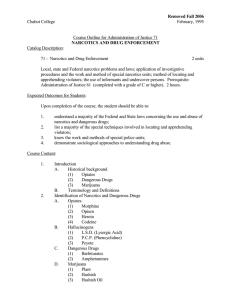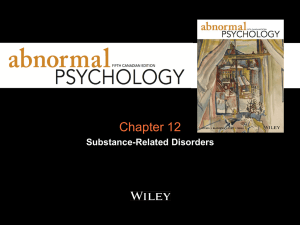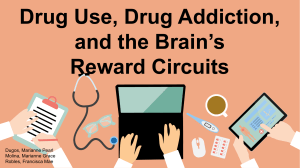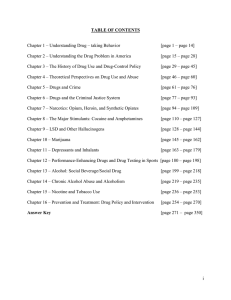Drugs and Consciousness
advertisement
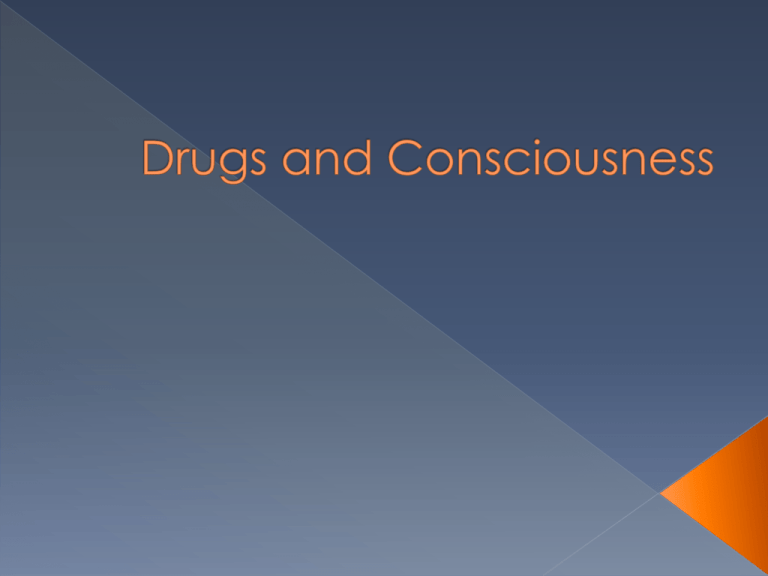
Broadly speaking, a drug is any substance that, when absorbed into the body of a living organism, alters normal bodily function. There is no single, precise definition, as there are different meanings in drug control law, government regulations, medicine, and recreational usage We will view the term drug through three different perspectives: medical utility, illegality, psychoactivity According to the Medical Utility model, a drug is defined as a substance that is used to treat or heal the body or mind Here, drugs are used to return the user to a state of normalcy, removing that which is pathological, abnormal or unnatural Examples: Penicillin, Aleve, Benadryl A psychoactive drug is any substance that has an effect on the mind Cocaine Alcohol Vicodin Marijuana In defining a drug based on the substance’s legal status, it would have to be determined whether possession or sale of the substance is legal or illegal. Alcohol (example: 4Loko) Marijuana Tylenol w/Codeine Instrumental: users take the drug out of necessity › Example: Using Xanax to quell anxiety Recreational: users take the drug simply to achieve a “buzz” or “high” › Example: Smoking marijuana to “feel good” Here, we are looking at the impact of drugs on the mind The actions of some drugs can conduce (lead/contribute to) certain behaviors Many drugs have extreme toxicity, and others produce a powerful dependence in users Drug abuse refers to a maladaptive pattern of use of a substance that is not considered dependent Dependence refers to the continued use of the drug despite problems related to use of the substance. Compulsive and repetitive use may result in tolerance to the effect of the drug and withdrawal symptoms when use is reduced or stopped › Physical: a process by which the body adjusts to and comes to need the drug for its everyday functioning. › Psychological: a desire to obtain or use a drug even though the physical dependence is not present Acute: one’s immediate reaction to taking a drug, ie: overdose, motor discoordination Chronic: the long term results of continued usage of a substance, ie: cirrhosis of the liver after 30 years of heavy drinking, lung cancer after decades of smoking Pharmacological: over time, neurons become increasingly insensitive to a drug, so the drug becomes decreasingly ineffective Cross: use of one drug leads to tolerance of a similar drug, ie: tolerance of heroin will produce tolerance to morphine, both are narcotics Behavioral: refers to an experienced users compensation for the effects of a given drug, ie: an experienced drinker may have trained themselves to “drive” under the influence, as opposed to someone who has taken a few drinks and gotten behind the wheel for the first time. Intravenously (IV) Smoking Inhalation Oral Depressants: temporarily reduce the function or activity of a specific part of the body or brain. Also known as “downers” When used, the effects may include cognitive/memory impairment, muscle relaxation, lowered blood pressure/heart rate, and possible feelings of euphoria Stimulants: induce temporary improvements in either mental or physical function or both. Also known as “uppers” These kinds of effects may include enhanced alertness, wakefulness, and locomotion, among others. Feelings of euphoria may also be felt, however, many stimulants can also cause anxiety and heart failure. Hallucinogens: can cause subjective changes in perception, thought, emotion and consciousness Dissociative Anesthetics: reduce or block signals to the conscious mind from other parts of the brain, yet they have the ability to induce hallucinogenic effects Narcotics are powerful drugs that give users feelings of euphoria, yet have a notably powerful sleep-inducing property
